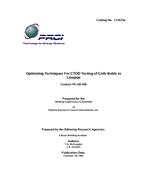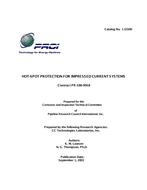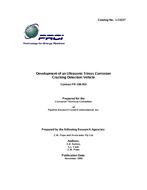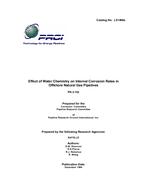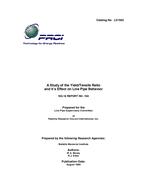Provide PDF Format
PRCI PR-185-906
- Optimizing Techniques for CTOD Testing of Girth Welds
- Report / Survey by Pipeline Research Council International, 02/18/1991
- Publisher: PRCI
$98.00$195.00
L51635e
Edison Welding Institute
Need: Appendix A of the sixteenth edition of API Standard 1104 allows relaxation of the flaw acceptance criteria, as defined in the standard, provided that specified minimum fracture toughness values are achieved (Ref.1). The fracture toughness is measured using the crack tip opening displacement (CTOD) test procedure as described in BS 5762 published by the British Standards Institute. In allowing relaxed defect acceptance criteria, the achievement of a specified CTOD value ensures that the flaws in girth welds will remain stable during installation and service. Thus, despite the presence of flaws, the pipeline can be operated safely without risk of unstable fracture, e.g. brittle fracture. However, to ensure that this is the case, it is vital that the testing procedure be designed to identify and quantify the lowest toughness region. If this is not done, there is a risk that the flaw will sample low toughness material and initiate an unstable fracture leading to failure of the girth weld.
Result: This report describes a research program to investigate various notching techniques with the objective of determining the most appropriate method of selecting the notch location for CTOD specimens notched into the HAZ region of pipeline girth welds. It was found that for the weld samples studied in this investigation, the API 1104 Appendix A method of conducting HAZ CTOD tests can produce scattered results and does not necessarily guarantee lower bound estimates of toughness. Of the various notching techniques studied, specimens notched at the intersection of the fusion boundary with the specimen mid-thickness produced the most consistent results.
Benefit: While the results indicate certain trends, one must bear in mind the limitations of this particular study. The results of this program were obtained using a single length of pipe of one particular size and grade, containing girth welds produced utilizing a single welding procedure, employing one type of consumable. To provide general conclusions, further studies should be undertaken to investigate the effects of different combinations of pipe materials, welding procedures and consumables. Once these studies are completed, it should be possible to define how many specimens are need to determine a lower bound estimate of HAZ toughness and to determine the best statistical procedure for assessing the distribution of toughness data in pipeline girth welds.
Edison Welding Institute
Need: Appendix A of the sixteenth edition of API Standard 1104 allows relaxation of the flaw acceptance criteria, as defined in the standard, provided that specified minimum fracture toughness values are achieved (Ref.1). The fracture toughness is measured using the crack tip opening displacement (CTOD) test procedure as described in BS 5762 published by the British Standards Institute. In allowing relaxed defect acceptance criteria, the achievement of a specified CTOD value ensures that the flaws in girth welds will remain stable during installation and service. Thus, despite the presence of flaws, the pipeline can be operated safely without risk of unstable fracture, e.g. brittle fracture. However, to ensure that this is the case, it is vital that the testing procedure be designed to identify and quantify the lowest toughness region. If this is not done, there is a risk that the flaw will sample low toughness material and initiate an unstable fracture leading to failure of the girth weld.
Result: This report describes a research program to investigate various notching techniques with the objective of determining the most appropriate method of selecting the notch location for CTOD specimens notched into the HAZ region of pipeline girth welds. It was found that for the weld samples studied in this investigation, the API 1104 Appendix A method of conducting HAZ CTOD tests can produce scattered results and does not necessarily guarantee lower bound estimates of toughness. Of the various notching techniques studied, specimens notched at the intersection of the fusion boundary with the specimen mid-thickness produced the most consistent results.
Benefit: While the results indicate certain trends, one must bear in mind the limitations of this particular study. The results of this program were obtained using a single length of pipe of one particular size and grade, containing girth welds produced utilizing a single welding procedure, employing one type of consumable. To provide general conclusions, further studies should be undertaken to investigate the effects of different combinations of pipe materials, welding procedures and consumables. Once these studies are completed, it should be possible to define how many specimens are need to determine a lower bound estimate of HAZ toughness and to determine the best statistical procedure for assessing the distribution of toughness data in pipeline girth welds.
Related Products
PRCI PR-198-903
Development of an Ultrasonic Stress Corrosion Cracking Detection Vehicle..
$198.00 $395.00
PRCI PR-3-152
Effects of Water Chemistry on Internal Corrosion Rates in Offshore Natural Gas Pipelines..
$148.00 $295.00

